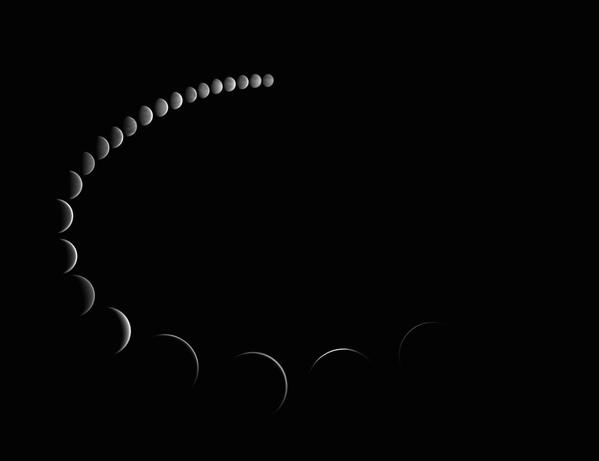This page describes an image Phases of Venus
Image caption:
This is a mesmerising series of images of Venus captured from Surgères, Charente-Maritime, France, over a period of six months in 2015. The phases appear similar to the phases we see of our own Moon and occur for similar reasons. Only half of Venus is illuminated by the Sun and, from Earth, we can sometimes only see part of that illuminated half, depending on the relative positions of the Sun, Earth and Venus. Both Mercury and Venus exhibit phases because their orbit is between the Sun and the orbit of Earth. Depending on the position of Venus relative to the Sun and Earth, Venus goes through its phases over a period of time. This sequence of images beautifully showcases the transition from the ‘gibbous’ to the slender crescents. The use of infrared filters helped to capture Venus's dense perpetual cloud cover during daylight in sharp detail, providing a glimpse into the mysterious nature of the planet’s atmosphere.
Scroll to captions in other languages
Image credit:
Stephane Gonzales/IAU OAE (CC BY 4.0)
DOI: 10.5281/zenodo.10278493
Tags:
astrophotography
Related glossary terms:
Phase
, Venus
Categories:
Solar System
Image license: Creative Commons Attribution 4.0 International (CC BY 4.0) Creative Commons Attribution 4.0 International (CC BY 4.0) icons
The media file captions presented on the OAE website were written, translated and reviewed by a collective effort from the OAE, the OAE Centers and Nodes, the OAE National Astronomy Education Coordinators (NAECs) and other volunteers. You can find a full list of credits for our translation project here. All media file captions are released under a Creative Commons CC BY-4.0 license and should be credited to "IAU OAE". The media files themselves may have different licenses (see above) and should be credited as listed above under "credit".
If you notice a factual error in this caption or an error in any of its translations then please get in touch.
Captions in Different Languages:
Image caption: Diese faszinierende Bilderserie der Venus wurde im Jahr 2015 über einen Zeitraum von sechs Monaten in Surgères im französischen Département Charente-Maritime aufgenommen. Die Phasen ähneln den Phasen, die wir bei unserem Mond sehen, und treten aus ähnlichen Gründen auf. Nur eine Hälfte der Venus wird von der Sonne beleuchtet, und von der Erde aus können wir manchmal nur einen Teil dieser beleuchteten Hälfte sehen, je nachdem wie Sonne, Erde und Venus zueinander stehen. Sowohl Merkur als auch Venus weisen Phasen auf, weil ihre Umlaufbahnen zwischen der Sonne und der Erdbahn liegen. Je nach Position der Venus relativ zu Sonne und Erde durchläuft die Venus ihre Phasen über einen bestimmten Zeitraum. Diese Bildsequenz zeigt sehr schön den Übergang von der abnehmenden Phase nach der "Vollvenus" hin zu immer schmaleren Sicheln. Der Einsatz von Infrarotfiltern half dabei, die dichte, immerwährende Wolkendecke der Venus bei Tageslicht in scharfen Details einzufangen, was einen Einblick in die geheimnisvolle Natur der Atmosphäre des Planeten ermöglicht.
Image credit: Stephane Gonzales/IAU OAE (CC BY 4.0)
Related glossary terms: Phase , Venus (Planet) Caption translation status: Not yet approved by a reviewer
Caption translators: Carolin Liefke
Image caption: Vincitore del primo posto del concorso di astrofotografia IAU OAE 2023, categoria Immagini fisse delle fasi di Venere: Fasi di Venere, di Stephane Gonzales
Si è aggiudicata il primo posto nella categoria Immagini fisse di fasi di Venere questa ipnotica serie di immagini catturate da Surgères, Charente-Maritime, Francia, in un periodo di sei mesi nel 2015. Le fasi appaiono simili a quelle della nostra Luna e si verificano per motivi analoghi. Solo metà di Venere è illuminata dal Sole e, dalla Terra, a volte possiamo vedere solo una parte di questa metà illuminata, a seconda delle posizioni relative di Sole, Terra e Venere. Sia Mercurio che Venere presentano delle fasi perché la loro orbita si trova tra il Sole e l'orbita della Terra. A seconda della posizione di Venere rispetto al Sole e alla Terra, Venere attraversa le sue fasi per un certo periodo di tempo. Questa sequenza di immagini mostra magnificamente la transizione dalle mezzelune "gibbose" a quelle più sottili. L'uso di filtri all'infrarosso ha permesso di catturare la densa e perpetua copertura nuvolosa di Venere durante la luce del giorno con dettagli nitidi, fornendo uno sguardo alla natura misteriosa dell'atmosfera del pianeta.
Image credit: Stephane Gonzales/IAU OAE (CC BY 4.0)
Related glossary terms: Fase , Venere (pianeta) Caption translation status: Not yet approved by a reviewer
Caption translators: Valentina La Parola
Image caption: 这是2015年在法国滨海夏朗德省的叙热尔拍摄的令人着迷的金星系列照片,历时六个月。这些相位与我们所看到的月相非常相似,且成因也相近。金星只有半边被太阳照亮,而从地球上看,我们有时只能看到被照亮部分的一部分,这取决于太阳、地球和金星的相对位置。由于水星和金星的轨道都位于太阳和地球轨道之内,它们都会因此呈现出相位变化。金星的相位会随着其相对于太阳和地球的位置变化而渐变。这一系列照片生动地展现了金星从‘凸状’到纤细‘弦状’的相位转变。使用红外滤镜能让我们在白天捕捉到金星致密而永久云层的清晰细节,为人们提供了一个观察这颗神秘行星大气层的独特视角。
Image credit: 斯特凡·冈萨雷斯/国际天文学联合会教育办公室 (CC BY 4.0)
Related glossary terms: 相位 , 金星 Caption translation status: Approved by a reviewer
Caption translators: Li Jiankang
Caption reviewers: Wang Yilin
Image caption: 這是2015年在法國濱海夏朗德省的敘熱爾拍攝的令人著迷的金星系列照片,歷時六個月。這些相位與我們所看到的月相非常相似,且成因也相近。金星只有半邊被太陽照亮,而從地球上看,我們有時只能看到被照亮部分的一部分,這取決於太陽、地球和金星的相對位置。由於水星和金星的軌道都位於太陽和地球軌道之內,它們都會因此呈現出相位變化。金星的相位會隨著其相對於太陽和地球的位置變化而漸變。這一系列照片生動地展現了金星從‘凸狀’到纖細‘弦狀’的相位轉變。使用紅外濾鏡能讓我們在白天捕捉到金星緻密而永久雲層的清晰細節,為人們提供了一個觀察這顆神祕行星大氣層的獨特視角。
Image credit: 斯特凡·岡薩雷斯/國際天文學聯合會教育辦公室 (CC BY 4.0)
Related glossary terms: 相位 , 金星 Caption translation status: Approved by a reviewer
Caption translators: An automated transliteration from the simplified Chinese translation by - Li Jiankang









